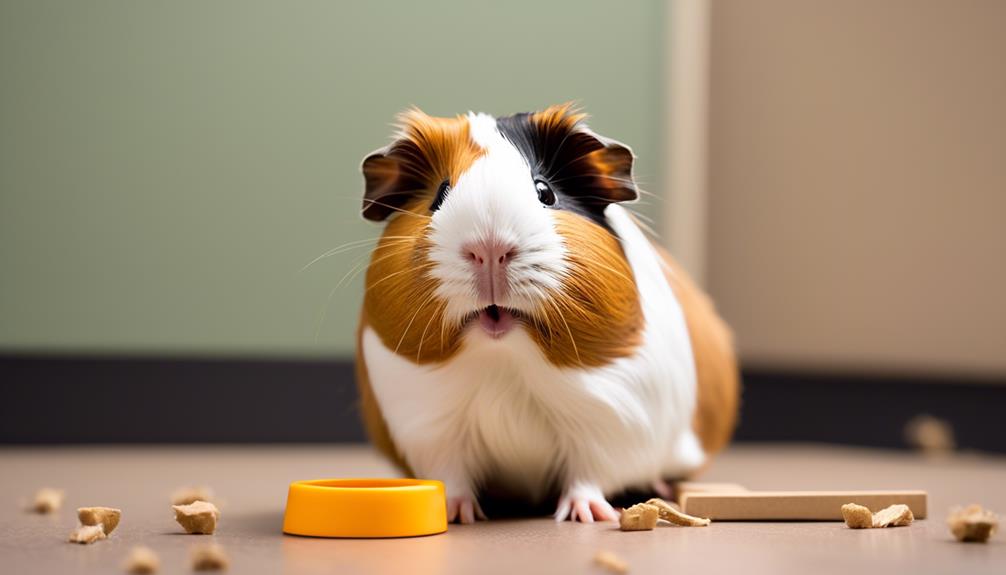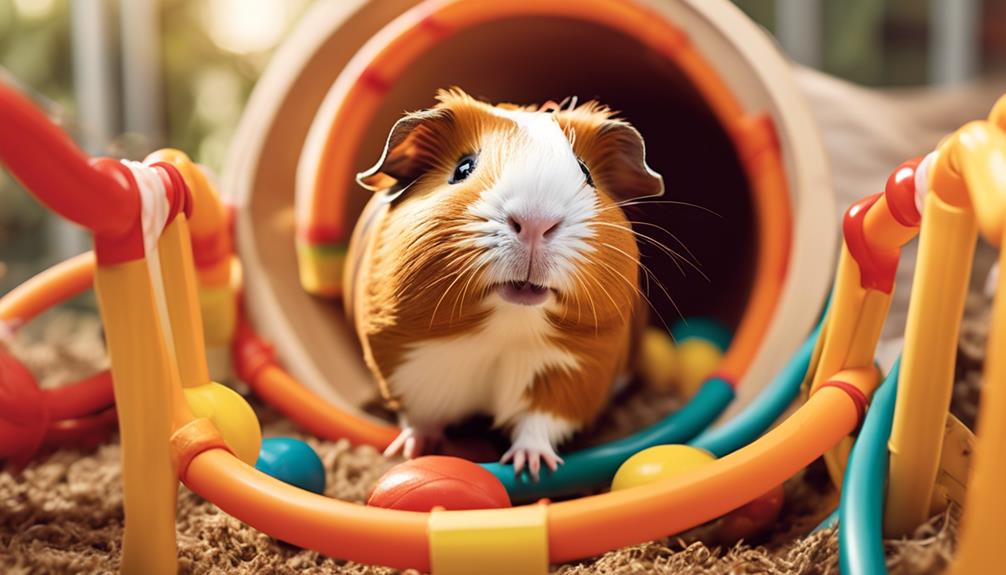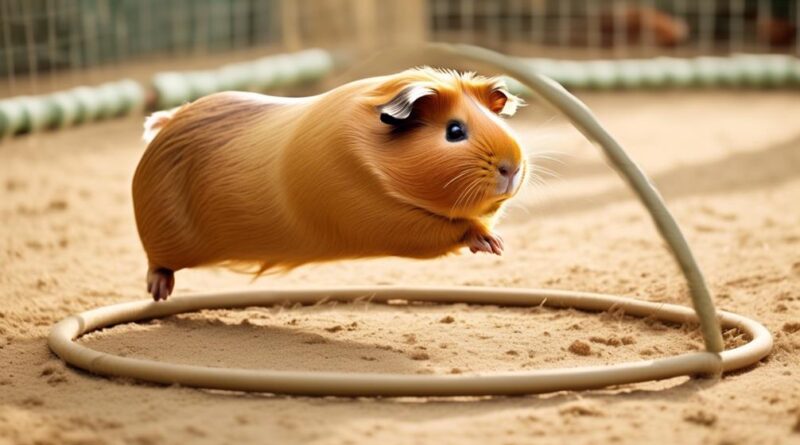Triumphant Training Techniques for Your Guinea Pig
You may not be aware that guinea pigs are highly intelligent and can be trained to perform a variety of tricks and behaviors. From simple commands to agility training, there are numerous techniques that can be used to train your guinea pig.
Whether you are a new guinea pig owner or looking to enhance your current training methods, understanding these techniques will not only create a stronger bond between you and your pet but also provide mental stimulation and enrichment for your furry friend.
But where do you start and how do you ensure successful training?
Setting Up the Training Environment
When setting up the training environment for your guinea pig, consider creating a quiet and spacious area for them to learn and explore. Creating a safe, comfortable environment is essential for your guinea pig's training success. Start by choosing a calm area in your home where your guinea pig won't be disturbed by loud noises or sudden movements. Ensure the space is free of potential hazards such as electrical cords, toxic plants, or small objects that your guinea pig could ingest.
To further encourage exploration and interaction, provide your guinea pig with plenty of hiding spots and tunnels to investigate. Guinea pigs love to explore, and having various textures and objects to interact with will keep them engaged and curious. Additionally, include some interactive toys or puzzles to stimulate their minds and provide mental enrichment.
In this environment, your guinea pig will feel comfortable and secure, allowing them to focus on the training activities without feeling stressed or anxious. It's important to remember that a comfortable and safe training space will positively impact your guinea pig's willingness to engage in learning.
Establishing Trust and Bonding
After creating a safe and engaging training environment for your guinea pig, the next essential step is establishing trust and bonding with your furry companion. Building confidence and rapport is crucial for a strong and lasting bond with your pet.
Here are some trust exercises and bonding activities to help you and your guinea pig develop a deep connection:
- Hand-Feeding: Offer treats from your hand to help your guinea pig associate you with positive experiences and build trust.
- Gentle Handling: Spend time gently petting and holding your guinea pig to help them feel secure and comfortable in your presence.
- Interactive Play: Engage in interactive play sessions using toys and tunnels to create a fun and bonding experience for your guinea pig.
- Verbal Communication: Talk to your guinea pig in a soothing and calming voice to help them recognize and feel comforted by your presence.
- Exploration Together: Allow your guinea pig to explore a safe and enclosed space while you sit nearby, providing a sense of security and support.
Teaching Basic Commands

To begin teaching basic commands to your guinea pig, establish a consistent and positive training routine. Start with simple commands like 'come' and 'stay' to lay the foundation for more advanced training.
When handling and grooming your guinea pig, use these moments as opportunities to reinforce basic commands. For instance, say 'stay' while gently holding your guinea pig during grooming sessions. This helps them associate the command with a specific action. Always use positive reinforcement, such as treats and verbal praise, to encourage your guinea pig to follow the commands.
Socializing and introducing your guinea pig to new environments also present chances to practice basic commands. When introducing your guinea pig to a new space, use commands like 'come' to encourage them to explore while still returning to you for reassurance. This helps build trust and reinforces the command in a different setting.
Additionally, socializing your guinea pig with other pets or humans provides opportunities to practice commands in a more dynamic environment. Remember to be patient and consistent in your training efforts, as guinea pigs, like all animals, require time to understand and respond to commands.
Positive Reinforcement Techniques
As you continue training your guinea pig, reinforcing basic commands through positive techniques is essential for their learning and development. Utilizing reward-based training and encouraging good behavior creates a positive atmosphere for your guinea pig to thrive in.
Here are some effective positive reinforcement techniques to implement in your guinea pig's training:
- Treat Rewards: Offering small, delicious treats as a reward for following commands or displaying desired behavior can reinforce positive actions.
- Verbal Praise: Guinea pigs respond well to gentle, soothing voices. Offering verbal praise when they successfully perform a command helps them associate the action with positive feedback.
- Clicker Training: Using a clicker to mark the desired behavior followed by a treat helps your guinea pig understand exactly when they've done something right.
- Playtime Rewards: Allowing your guinea pig some extra playtime as a reward for good behavior can be highly motivating for them.
- Consistency: Consistently rewarding good behavior and promptly ignoring undesired behavior helps your guinea pig understand what's expected of them.
Clicker Training for Guinea Pigs
Clicker training can be a highly effective method for teaching guinea pigs specific behaviors and commands. It involves using a small clicker device that makes a distinct sound, paired with positive reinforcement in the form of treats. The key to successful clicker training is timing and consistency. When your guinea pig performs the desired behavior, you must click the device at the exact moment it occurs, followed immediately by giving them a treat. This creates a clear association between the click sound and the reward, helping to shape their behavior.
Using treats is an essential part of clicker training for guinea pigs. It's important to use small, healthy treats that your guinea pig enjoys. By offering these treats as a reward for the behavior you want to encourage, you can effectively reinforce that specific action. Additionally, treats can help to build your guinea pig's confidence during training sessions, making them more eager to participate and learn.
Shaping behavior is another crucial aspect of clicker training. This involves breaking down the desired behavior into smaller steps and rewarding your guinea pig for each step towards the final behavior. By gradually shaping their actions, you can guide them to perform more complex behaviors over time.
Mastering clicker timing is the cornerstone of successful training. The click must precisely coincide with the desired behavior for your guinea pig to make the association between the click and the reward. With practice and patience, you can hone your clicker timing skills to effectively communicate with your guinea pig during training sessions.
Addressing Behavioral Challenges
When addressing behavioral challenges in guinea pigs, it's important to understand that consistent clicker training can also help in modifying negative behaviors. Behavior modification in guinea pigs can be achieved through problem-solving techniques that are both effective and humane.
- Positive Reinforcement: Use treats and praise to reward positive behaviors such as using the litter box or not biting.
- Consistency: Be consistent in your training approach and expectations to avoid confusing your guinea pig.
- Environmental Enrichment: Provide stimulating toys and activities to prevent boredom and destructive behaviors.
- Socialization: Encourage positive social interactions with other guinea pigs to prevent loneliness and aggression.
- Patience: Understand that behavior modification takes time and effort, so be patient and persistent in your training.
Training for Agility and Fun

To enhance your guinea pig's physical and mental stimulation, consider incorporating agility training into their routine. Guinea pigs are intelligent and curious animals, and agility training provides an excellent opportunity to engage their minds and keep them physically active.
Setting up a mini obstacle course in a safe, enclosed area can be a fun way to introduce agility training to your guinea pig. You can use tunnels, small ramps, and low hurdles to create a simple course for them to navigate through. Encourage your guinea pig to explore and conquer the obstacles by using their favorite treats as rewards. This will motivate them to complete the course and make the training experience enjoyable for them.
In addition to agility training, trick training can also be a great way to bond with your guinea pig and provide them with mental stimulation. Teaching your guinea pig simple tricks like spinning in a circle, standing on their hind legs, or jumping over a small obstacle can be both entertaining and enriching for them. Use positive reinforcement, such as treats and verbal praise, to encourage and reward their efforts. Keep training sessions short and enjoyable, and always be patient with your guinea pig as they learn new tricks.
Agility training and trick training are fantastic ways to keep your guinea pig active, engaged, and entertained. Remember to always prioritize your guinea pig's safety and comfort during training sessions, and have fun exploring the endless possibilities of training and bonding with your furry companion.
Maintaining Consistency and Patience
Consistency and patience are key when it comes to training your guinea pig, as they require time and repetition to learn and master new skills. It's important to maintain a consistent training schedule and approach to help your guinea pig understand what's expected of them.
Here are some tips to help you maintain consistency and patience in your guinea pig training:
- Training rewards: Using treats as rewards for good behavior can help reinforce positive actions and motivate your guinea pig to continue learning. Choose healthy treats like small pieces of fruits or vegetables to keep your guinea pig engaged and excited during training sessions.
- Behavioral cues: Consistently using the same verbal and visual cues during training will help your guinea pig understand what's expected of them. For example, using a specific word or hand signal to indicate a desired behavior will help your guinea pig associate the cue with the action.
- Routine training sessions: Establishing a regular training routine will help your guinea pig become familiar with the training process and what's expected of them. Consistent training sessions will also help reinforce learning and prevent confusion.
- Positive reinforcement: Patience is key when it comes to training your guinea pig. Use positive reinforcement techniques such as praise and treats to encourage good behavior and progress, even if it takes time for your guinea pig to fully grasp a new skill.
- Clear communication: Be patient and consistent in your communication with your guinea pig. Use clear and simple commands to avoid confusion and help your guinea pig understand what you're asking of them.
Frequently Asked Questions
Can Guinea Pigs Be Trained to Do Tricks Like Dogs or Cats?
Yes, guinea pigs can definitely be trained to do tricks like dogs or cats. With training consistency and positive reinforcement, you can teach them to perform various tricks.
Behavior reinforcement and clicker training are effective techniques for teaching your guinea pig new tricks. By using these methods, you can train your guinea pig to respond to commands and perform fun tricks, just like dogs or cats!
How Long Should Training Sessions Be and How Often Should They Be Conducted?
When training your guinea pig, the frequency of sessions and the effective duration are crucial. It's best to conduct short training sessions daily to keep your pet engaged and focused. Aim for around 10-15 minutes per session to prevent your guinea pig from becoming overwhelmed or bored.
This approach will help reinforce positive behaviors and improve the overall success of your training efforts.
Are There Any Specific Foods That Guinea Pigs Respond to Best as a Reward During Training?
When training your guinea pig, it's important to use the best treats for positive reinforcement techniques. Fruits like apples and strawberries are usually a hit, and veggies like carrots and bell peppers also make great rewards.
These treats provide a good balance of nutrition and deliciousness, which can motivate your guinea pig to learn and perform tricks. Using these as rewards can help make training sessions more effective and enjoyable for your pet.
What Are Some Common Mistakes That People Make When Training Their Guinea Pigs?
When training your guinea pig, common mistakes include:
- Inconsistent training
- Using punishment instead of positive reinforcement techniques
- Expecting too much too soon
Instead, focus on:
- Using positive reinforcement, such as treats, to encourage good behavior
- Being patient and consistent with your training methods
- Avoiding overwhelming your guinea pig with too many commands at once
How Do You Handle a Guinea Pig That Is Particularly Stubborn or Resistant to Training?
When handling resistance from your guinea pig during training, it's important to stay patient and consistent.
Use positive reinforcement techniques such as treats and praise to encourage desired behaviors.
If your guinea pig is particularly stubborn, try breaking down the training into smaller steps and rewarding progress along the way.
Remember to maintain a calm and gentle approach, and avoid forcing your guinea pig to comply with training.
Conclusion
In conclusion, training your guinea pig can be a rewarding and enjoyable experience for both you and your furry friend. By creating a positive and consistent training environment, using positive reinforcement techniques, and maintaining patience, you can teach your guinea pig basic commands, address behavioral challenges, and even train them for agility.
With time and dedication, you can build a strong bond with your guinea pig and have fun while doing it.
